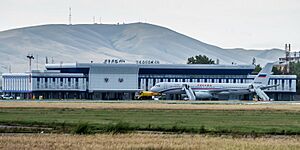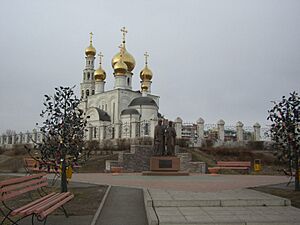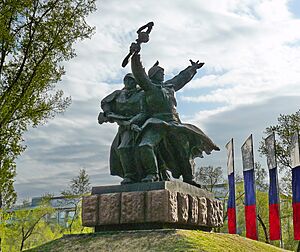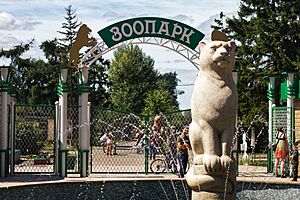Abakan facts for kids
Quick facts for kids Abakan (English)Абакан (Russian) Ағбан, Абахан (Khakas) |
|
|---|---|
| - City - | |
 Statue in Abakan |
|
|
|
|
| City Day | Second to last Saturday in August |
| Administrative status | |
| Country | Russia |
| Federal subject | Republic of Khakassia |
| Administratively subordinated to | City of Abakan |
| Capital of | Republic of Khakassia |
| Municipal status | |
| Urban okrug | Abakan Urban Okrug |
| Head | Alexey Lemin |
| Representative body | Council of Deputies |
| Statistics | |
| Population (2010 Census, preliminary) |
165,214 inhabitants |
| - Rank in 2010 | 109th |
| Population (January 2014 est.) | 173,200 inhabitants |
| Time zone | KRAT (UTC+08:00) |
| Founded | 1675 |
| City status since | 30 April 1931 |
| Postal code(s) | 655000–655012, 655014–655019, 655022, 655400, 655899, 655961, 655965, 655966 |
| Dialing code(s) | +7 3902 |
| Official website: http://абакан.рф | |
Abakan (Russian: Абака́н; Khakas: Ағбан, Ağban, or Абахан, Abaxan) is an important city in Russia. It is the capital of the Republic of Khakassia. The city is located where the Yenisei and Abakan Rivers meet. This area is known as the Minusinsk Depression.
In 2010, about 165,214 people lived in Abakan. This number has grown over the years. For example, in 1989, there were about 154,092 residents.
Contents
History of Abakan
The first settlement in this area was a fortress called Abakansky ostrog. It was built in 1675 at the mouth of the Abakan River. Later, in the 1780s, a village named Ust-Abakanskoye grew in the same spot. Abakan officially became a city on April 30, 1931, and got its current name.
Ancient Palace Discovery
In 1940, workers building a highway near Abakan found some very old ruins. Archaeologists explored the site from 1941 to 1945. They discovered a large palace, about 1500 square meters in size. This palace was built in an ancient Chinese style. It likely dates back to the Han dynasty (206 BC–220 AD).
It was a mystery why a Chinese-style palace was built so far from China. Experts believe a very important person lived there. One idea is that it was the home of Li Ling. He was a Chinese general who joined the Xiongnu people after a battle in 99 BCE. Another idea is that it belonged to Lu Fang, who wanted to be emperor during the Han dynasty.
People from Other Lands
During the late 1700s and 1800s, many people from Lithuania and Poland were sent to Abakan. They were involved in rebellions against Russian rule. Some of these people were forced to work in coal mines. After a leader named Joseph Stalin died, more Lithuanian people moved to Abakan from nearby settlements.
Today, some descendants of these Polish exiles still live in the Khakassia region. A local Polish school was opened in 1994. It received support from the local government until 2014. In 1999, Khakassian State University even started offering Polish language classes.
City Government
Abakan is the capital city of the Republic of Khakassia. This means it is the main center for the republic's government. It is managed as the City of Abakan, which is a special administrative area. For local government, it is known as the Abakan Urban Okrug. The city is led by a "Head," and its local laws are made by the Council of Deputies.
What Abakan Makes and Does
Abakan is a city with many businesses and educational places. It has factories that make things like footwear (shoes), foodstuffs, and metal products. The city is also home to the Katanov State University of Khakasia. There are also three theaters where you can watch plays and performances.
Getting Around
Abakan is an important place for trains. It used to be the end point of a big railway line called the Abakan-Taishet Railway. Now, it is a major railway junction where different train lines connect. The city also has its own airport, the Abakan International Airport. This airport helps people travel to and from Abakan by air.
Places to See
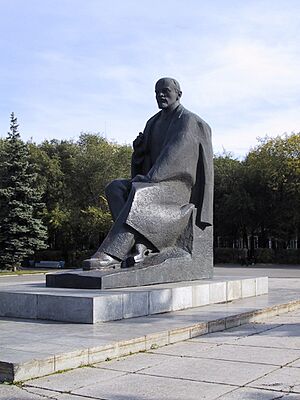
If you visit Abakan, here are some interesting places:
- Holy Transfiguration Cathedral: This is a beautiful church.
- "Good Angel of Peace" sculpture: A special statue that represents peace.
- Park of Topiary Art: A park with plants shaped into different designs.
- Khakas National local history museum: A museum named after Leonid Kyzlasov. It teaches about the history and culture of the Khakas people.
Sports in Abakan
Bandy is a very popular sport in Abakan. It is similar to hockey but played with a ball. The city has a bandy team called Sayany-Khakassia. They used to play in the top league in Russia. Since 2013, they have been playing in the Russian Bandy Supreme League. Abakan has also hosted the Russian Government Cup for bandy in 1988 and 2012.
Geography
Abakan has a type of climate called a dry-winter continental climate. This means it has very big temperature differences between seasons. Summers can be warm, and winters are very cold, which is common in Siberia. The city gets most of its rain in the summer. It gets less rain at other times because nearby mountains block some of the moisture.
| Climate data for Abakan | |||||||||||||
|---|---|---|---|---|---|---|---|---|---|---|---|---|---|
| Month | Jan | Feb | Mar | Apr | May | Jun | Jul | Aug | Sep | Oct | Nov | Dec | Year |
| Record high °C (°F) | 7.2 (45.0) |
9.1 (48.4) |
20.2 (68.4) |
33.5 (92.3) |
37.6 (99.7) |
37.1 (98.8) |
38.5 (101.3) |
36.3 (97.3) |
34.3 (93.7) |
24.5 (76.1) |
15.6 (60.1) |
7.5 (45.5) |
38.5 (101.3) |
| Mean maximum °C (°F) | 0.1 (32.2) |
1.8 (35.2) |
11.6 (52.9) |
22.5 (72.5) |
30.1 (86.2) |
32.3 (90.1) |
33.7 (92.7) |
31.5 (88.7) |
25.9 (78.6) |
18.3 (64.9) |
8.3 (46.9) |
1.8 (35.2) |
34.5 (94.1) |
| Mean daily maximum °C (°F) | −12.3 (9.9) |
−8.6 (16.5) |
1.0 (33.8) |
11.5 (52.7) |
19.9 (67.8) |
24.7 (76.5) |
26.8 (80.2) |
24.1 (75.4) |
17.0 (62.6) |
8.5 (47.3) |
−2.4 (27.7) |
−9.7 (14.5) |
8.4 (47.1) |
| Daily mean °C (°F) | −17.8 (0.0) |
−15.2 (4.6) |
−5.4 (22.3) |
4.4 (39.9) |
12.3 (54.1) |
17.8 (64.0) |
20.4 (68.7) |
17.6 (63.7) |
10.7 (51.3) |
2.9 (37.2) |
−7.2 (19.0) |
−14.8 (5.4) |
2.1 (35.9) |
| Mean daily minimum °C (°F) | −23.3 (−9.9) |
−21.8 (−7.2) |
−11.8 (10.8) |
−2.7 (27.1) |
4.6 (40.3) |
10.9 (51.6) |
13.9 (57.0) |
11.0 (51.8) |
4.3 (39.7) |
−2.7 (27.1) |
−11.9 (10.6) |
−19.9 (−3.8) |
−4.1 (24.6) |
| Mean minimum °C (°F) | −34.9 (−30.8) |
−33.5 (−28.3) |
−25.7 (−14.3) |
−11.6 (11.1) |
−5.0 (23.0) |
3.3 (37.9) |
8.4 (47.1) |
4.3 (39.7) |
−3.3 (26.1) |
−12.1 (10.2) |
−24.5 (−12.1) |
−32.7 (−26.9) |
−37.4 (−35.3) |
| Record low °C (°F) | −47.6 (−53.7) |
−45.1 (−49.2) |
−38.7 (−37.7) |
−23.2 (−9.8) |
−11.1 (12.0) |
−3.6 (25.5) |
1.2 (34.2) |
0.2 (32.4) |
−9.5 (14.9) |
−22.9 (−9.2) |
−37.6 (−35.7) |
−43.8 (−46.8) |
−47.6 (−53.7) |
| Average precipitation mm (inches) | 7.3 (0.29) |
5.6 (0.22) |
4.6 (0.18) |
12.3 (0.48) |
27.9 (1.10) |
55.8 (2.20) |
66.0 (2.60) |
61.5 (2.42) |
35.5 (1.40) |
16.1 (0.63) |
10.1 (0.40) |
8.0 (0.31) |
310.7 (12.23) |
| Average precipitation days | 2.6 | 2.0 | 1.4 | 3.4 | 5.9 | 9.3 | 8.8 | 9.4 | 7.2 | 3.8 | 3.1 | 2.4 | 59.3 |
| Source 1: Météo climat stats | |||||||||||||
| Source 2: Météo Climat | |||||||||||||
See also
 In Spanish: Abakán para niños
In Spanish: Abakán para niños



